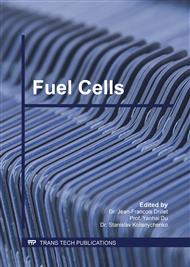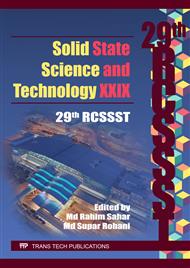[1]
An, J., Bae, J., Hong, S., Koo, B., Kim, Y. B., T. M., & Prinz, F. B. (2015). Grain boundary blocking of ionic conductivity in nanocrystalline yttria-doped ceria thin films. Scripta Materialia, 104, 45–48.
DOI: 10.1016/j.scriptamat.2015.03.020
Google Scholar
[2]
Bernay, C. E., Ringuedé, A., Colomban, P., Lincot, D., & Cassir, M. (2003).
Google Scholar
[3]
Chen, K., L¨, Z., Ai, N., Huang, X., Zhang, Y., Xin, Su, W. (2006). Development of yttria-stabilized zirconia thin films via slurry spin coating for intermediate-to-low temperature solid oxide fuel cells. Journal of Power Sources, 160(1), 436–438.
DOI: 10.1016/j.jpowsour.2006.01.079
Google Scholar
[5]
Chen, X. J., Khor, K. A., Chan, S. H., & Yu, L. G. (2004).
Google Scholar
[6]
Curtin, S., Gangi, J., IEA, Tan, E. K., Materials, N., Flexcell, Yu, Q. (2014). Development of Fuel Cell and Hydrogen 2OO9-2O1O. Technology Roadmap, 22(3), 55–62. http: /doi. org/10. 1039/b105764m.
Google Scholar
[7]
de Souza, S. (1997). Thin-film solid oxide fuel cell with high performance at low-temperature. Solid State Ionics, 98(1-2), 57–61.
DOI: 10.1016/s0167-2738(96)00525-5
Google Scholar
[8]
Depla, D., Besnard, A., & Lamas, J. (2016). The influence of the pressure on the microstructure of yttria-stabilized zirconia thin films deposited by dual magnetron sputtering. Vacuum, 125, 118–122.
DOI: 10.1016/j.vacuum.2015.12.013
Google Scholar
[9]
Dincer, I., & Colpan, C. O. (2013). Solid Oxide Fuel Cells, 41–44.
Google Scholar
[10]
Ding, J., & Liu, J. (2008). An anode-supported solid oxide fuel cell with spray-coated yttria-stabilized zirconia (YSZ) electrolyte film. Solid State Ionics, 179(21-26), 1246–1249.
DOI: 10.1016/j.ssi.2008.01.094
Google Scholar
[11]
Fabbri, E., Pergolesi, D., & Traversa, E. (2010). Electrode materials: a challenge for the exploitation of protonic solid oxide fuel cells. Science and Technology of Advanced Materials, 11(4), 044301.
DOI: 10.1088/1468-6996/11/4/044301
Google Scholar
[12]
Feng, H., Chen, L., Xie, Z., & Sun, F. (2015). Constructal optimization for a single tubular solid oxide fuel cell. Journal of Power Sources, 286, 406–413.
DOI: 10.1016/j.jpowsour.2015.03.162
Google Scholar
[13]
Garcia-Garcia, F. J., Yubero, F., González-Elipe, A. R., Balomenou, S. P., Tsiplakides, D., Petrakopoulou, I., & Lambert, R. M. (2015).
Google Scholar
[14]
Guo, C. X., Wang, J. X., He, C. R., & Wang, W. G. (2013). Effect of alumina on the properties of ceria and scandia co-doped zirconia for electrolyte-supported SOFC. Ceramics International, 39(8), 9575–9582.
DOI: 10.1016/j.ceramint.2013.05.076
Google Scholar
[15]
Halinen, M. (n. d. ). Improving the performance of solid oxide fuel cell systems.
Google Scholar
[16]
Hidalgo, H., Reguzina, E., Millon, E., Mathias, J., Boulmer-Leborgne, Brault, P. (2011). Yttria-stabilized zirconia thin films deposited by pulsed-laser deposition and magnetron sputtering. Surface and Coatings Technology, 205(19), 4495–4499.
DOI: 10.1016/j.surfcoat.2011.03.077
Google Scholar
[17]
Ikhu, D., Ahmad, W., Kawada, T., Sakai, N., Yokokawa, H., Dokiya, Tarancón, A. (2013). List of participant. ACS Nano, 13(9), xiii–xiv.
Google Scholar
[18]
Jeong, H. J., Kim, J. W., Bae, K., Jung, H., & Shim, J. H. (2013). Atomic Layer Deposition of Ruthenium on Platinum Anode for Direct Methanol Solid Oxide Fuel Cells. ECS Transactions, 57(1), 3059–3062.
DOI: 10.1149/05701.3059ecst
Google Scholar
[19]
Kishimoto, H., Yashiro, K., Shimonosono, T., Brito, M. E., Yamaji, K., Horita, T. Mizusaki, J. (2012).
Google Scholar
[20]
Ding, J., & Liu, J. (2008). An anode-supported solid oxide fuel cell with spray-coated yttria stabilized zirconia (YSZ) electrolyte film. Solid State Ionics, 179(21–26), 1246–1249.
DOI: 10.1016/j.ssi.2008.01.094
Google Scholar
[21]
Fabbri, E., Pergolesi, D., & Traversa, E. (2010). Electrode materials: a challenge for the exploitation of protonic solid oxide fuel cells. Science and Technology of Advanced Materials, 11(4), 44301.
DOI: 10.1088/1468-6996/11/4/044301
Google Scholar
[22]
Feng, H., Chen, L., Xie, Z., & Sun, F. (2015). Constructal optimization for a single tubular solid oxide fuel cell. Journal of Power Sources, 286, 406–413.
DOI: 10.1016/j.jpowsour.2015.03.162
Google Scholar
[23]
Garcia-Garcia, F. J., Yubero, F., González-Elipe, A. R., Balomenou, S. P., Tsiplakides, D., Petrakopoulou, I., & Lambert, R. M. (2015).
Google Scholar
[24]
Götsch, T., Mayr, L., Stöger-Pollach, M., Klötzer, B., & Penner, S. (2015). Preparation and characterization of epitaxially grown unsupported yttria-stabilized zirconia (YSZ) thin films. Applied Surface Science, 331, 427–436.
DOI: 10.1016/j.apsusc.2015.01.068
Google Scholar
[25]
Guo, C. X., Wang, J. X., He, C. R., & Wang, W. G. (2013). Effect of alumina on the properties of ceria and scandia co-doped zirconia for electrolyte-supported SOFC. Ceramics International, 39(8), 9575–9582.
DOI: 10.1016/j.ceramint.2013.05.076
Google Scholar



